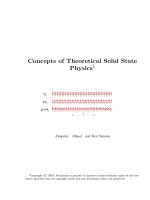Solid state physics - v karpus
Bạn đang xem bản rút gọn của tài liệu. Xem và tải ngay bản đầy đủ của tài liệu tại đây (6.35 MB, 182 trang )
Solid State Physics • Kietųjų kūnų fizika
Физика твердого тела • Festkörperphysik
Vytas Karpus
(PFI: 364 k.; tel.: 2619475 (of.), 2313217 (h.); )
/>V. Karpus, Solid State Physics: Lecture 1 (2004)
• C. Kittel, Introduction to Solid State Physics (John Willey & Sons, 1996)
Ч. Киттель, Введение в физику твердого тела (Москва: Наука, 1978)
• N. W. Ashcroft and N. D. Mermin, Solid State Physics, (Holt, Rinehart, and Winston,
1976)
Н. Ашкрофт, Н. Мермин, Физика твердого тела (Москва: Мир, 1979)
•J. M.Ziman, Principles of the Theory of Solids (Cambridge University Press, 1972)
Дж. Займан, Принципы теории твердого тела (Москва: Мир, 1974)
• А. С. Давыдов, Теория твердого тела (Москва: Наука, 1976)
• В. Л. Бонч-Бруевич, С. Г. Калашников, Физика полупроводников (Москва: Наука, 1977)
• A. Juodviršis, M. Mikalkevičius,S. Vengris, Puslaidininkių fizikos pagrindai
(Vilnius: Mokslas, 1985)
•A. Matulis, Kietojo kūno fizika (Vilnius: Petro ofsetas, 2000)
• V. Karpus, Kietųjų
kūnų fizika. Kristalinis būvis (Vilnius: Ciklonas, 2002)
Crystal structures
The crystalline state = the equilibrium state of solids
Experimental fact or theorem?
• long-range order
• periodicity
Crystals:
• point symmetry
• translation symmetry
Symmetry:
Investigations
of symmetry of crystals
(mineralogy)
• 17–18
th
c. Steno (1638–1686)
Haüy (1743–1822)
•19
th
c. Hessel, Bravais, Schönflies,
Fedorov (Е. С. Федоров)
Crystallography:
classification of crystals
V. Karpus, Solid State Physics: Lecture 1 (2004)
Translation symmetry
Wigner–Seitz cell
primitive cell
atoms & equivalent points
K,2,1,0
332211
, ±±=
+
+
=
i
n
nnn aaal
lattice vectors
vectors of primitive translations
a
1
a
2
translation operator
)()(
ˆ
lrr
l
+= ffT )exp(
ˆ
∇= l
l
T
crystal structure/lattice
Bravais lattice
])[(
321cell
aaa
=
V
atomic positions
αα
ρlR +=
nn
)0(
V. Karpus, Solid State Physics: Lecture 1 (2004)
Point symmetry
O
h
O
T
h
T
d
T
inversion centre
i
Schönflies Herman-Mauguin
1
O,T
h h
rotation axis
n
C
n
O, O
h
T, T , T
d h
rotation-inversion axis
in
C
n
rotation-reflection axis
n
S
T
d
mirror plane
σ
m
O, T
h h
O, T
h d
O, T
h d
V. Karpus, Solid State Physics: Lecture 1 (2004)
Point groups
A set of point symmetry operations of a body constitutes its point group
Examples of point groups:
• C
n
= rotations of C
n
-axis
• O = all rotations of a cube
• O
h
= C
i
× O
• T = all rotations of a tetrahedron
• T
h
= C
i
× T
• T
d
(4 C
3
, 3 S
4
, and 6 σ)
• C
nh
(C
1h
≡ C
s
) , C
nv
, D
n
(D
2
≡ V )
A set of elements A, B, C, is called a group G
if a law of their “multiplication” is defined,
and the following conditions are satisfied:
• if A and B ∈ G, then AB ∈ G
• multiplication is associative, (AB)C = A(BC)
• the set contains an element E such that
AE = EA = A
• for all A ∈ G there exist B such that
AB = BA = E
Group
V. Karpus, Solid State Physics: Lecture 1 (2004)
V. Karpus, Solid State Physics: Lecture 1 (2004)
Classification of crystals
System
Parameters of
crystallographic cell
Lattice
type
Point group
Triclinic (T)
a ≠ b ≠ c
α≠β≠γ
P
C
1
, C
i
Monoclinic (M)
a ≠ b ≠ c
α=γ= ½π≠β
P, C
C
2
, C
s
, C
2h
Orthorhombic (O)
a ≠ b ≠ c
α=β = γ = ½π
P, C, I,
F
D
2
, C
2v
, D
2h
Tetragonal (Q)
a = b ≠ c
α=β = γ = ½π
P, I
C
4
, S
4
, C
4h
, D
4
, C
4v
, D
2d
, D
4h
Trigonal
or rhombohedral (R)
a = b = c
α=β = γ≠½π
R
C
3
, C
3i
, D
3
, C
3v
, D
3d
Hexagonal (H)
a = b ≠ c
α=β = ½π, γ = 2π/3
P
C
6
, C
3h
, C
6h
, D
6
, C
6v
, D
3h
, D
6h
Cubic (K)
a = b = c
α=β = γ=½π
P, I, F
T , T
h
, T
d
, O , O
h
System
Parameters of
crystallographic cell
Lattice
type
Point group
Triclinic (T)
a ≠ b ≠ c
α≠β≠γ
P
C
1
, C
i
Monoclinic (M)
a ≠ b ≠ c
α=γ= ½π≠β
P, C
C
2
, C
s
, C
2h
Orthorhombic (O)
a ≠ b ≠ c
α=β = γ = ½π
P, C, I,
F
D
2
, C
2v
, D
2h
Tetragonal (Q)
a = b ≠ c
α=β = γ = ½π
P, I
C
4
, S
4
, C
4h
, D
4
, C
4v
, D
2d
, D
4h
Trigonal
or rhombohedral (R)
a = b = c
α=β = γ≠½π
R
C
3
, C
3i
, D
3
, C
3v
, D
3d
Hexagonal (H)
a = b ≠ c
α=β = ½π, γ = 2π/3
P
C
6
, C
3h
, C
6h
, D
6
, C
6v
, D
3h
, D
6h
Cubic (K)
a = b = c
α=β = γ=½π
P, I, F
T , T
h
, T
d
, O , O
h
Hessel 1830 Bravais 1848 Schönflies and Fedorov 1890-1894
Miller indices
[130]
[110]
(510)
(110)
a
b
c
wc
()
hkl
vb
ua
lkh
wvu
::
1
:
1
:
1
=
b
a
(110)
a
b
c
[]
hkl
lkhwvu ::::
=
[[ ]]
uvw
3 1
0
2 2
__
V. Karpus, Solid State Physics: Lecture 1 (2004)
Examples of crystal structures: Ionic crystals
Cs
+
Cl
-
Bravais lattice: sc
σ= 2
coordination number = 8
a = 4.11 Å
CsBr, CsI, β´-CuZn
N
a
+
Cl
-
Bravais lattice: fcc
σ= 2 (σ = 8)
coordination number = 6
a = 5.63 Å
KCl, AgBr, MgO, MnO
V. Karpus, Solid State Physics: Lecture 1 (2004)
Examples of crystal structures: Metallic crystals
Bravais lattice: bcc
σ= 1 (σ = 2)
coordination number = 8
a
Na
= 4.23 Å
Li, Na, K, Rb, Cs
a
c
b
7
4
3
6
2
5
bcc
1
2
3
4
5
6
7
8
(
)
()
()
cbaa
cbaa
cbaa
−+=
+−=
++−=
2
1
3
2
1
2
2
1
1
1
2
34
a
b
c
Bravais lattice: hexagonal
σ= 2 (σ = 6)
coordination number = 12
c/a = 1.633
Mg, Cd, Zn
hcp
(
)
()
()
baa
aca
cba
+=
+=
+=
2
1
3
2
1
2
2
1
1
8
1
2
3
4
5
6
7
fcc
Bravais lattice: fcc
σ= 1 (σ = 8)
coordination number = 12
Al, Cu, Ag, Ne
V. Karpus, Solid State Physics: Lecture 1 (2004)
Examples of crystal structures: Covalent crystals
Bravais lattice: fcc
σ= 2 (σ = 8)
coordination number = 4
a
C
= 3.56 Å
Si, Ge, α-Sn
diamond structure
Bravais lattice: fcc
σ= 2 (σ = 8)
coordination number = 4
a
ZnS
= 5.41 Å
GaAs, AlAs, ΙnP, CdTe
zinc blende structure
V. Karpus, Solid State Physics: Lecture 1 (2004)
The point symmetry of crystals determines
the symmetry of macroscopic physical quantities
Crystallophysics
Neumann, P. Curie, Voigt 19
th
c.
[J. F. Nye, Physical properties of Crystals (Clarendon Press, 1964)]
Tensors
E
j
isotropic
system
Ej
σ
=
j
E
crystal
⎪
⎩
⎪
⎨
⎧
++=
++=
++=
3332321313
3232221212
3132121111
EEEj
EEEj
EEEj
σσσ
σσσ
σσσ
Cartesian coordinates
Neumann principle
Symmetry of macroscopic physical quantities ≥ the point symmetry of a system
jiji
Ej
σ
=
sum
V. Karpus, Solid State Physics: Lecture 1 (2004)
Transformations
x
1
x
2
x
3
x
1
'
x
2
'
x
3
'
Vectors
Let the vector components in the old reference system are A = (A
1
, A
2
, A
3
)
What will be the A-components in the new system?
⎪
⎩
⎪
⎨
⎧
=
=
++=
K
K
'
'
)'cos()'cos()'cos('
3
2
3132121111
A
A
xxAxxAxxAA
x
1
x
2
x
3
x
1
'
A
A
1
'
A
1
A
2
A
3
jj
AaA
11
'or
=
old)via(new'
jiji
AaA
=
new)via(old'
jjii
AaA
=
Coordinate systems
⎟
⎟
⎟
⎠
⎞
⎜
⎜
⎜
⎝
⎛
=
)'cos()'cos()'cos(
)'cos()'cos()'cos(
)'cos()'cos()'cos(
332313
322212
312111
xxxxxx
xxxxxx
xxxxxx
a
ij
transformation matrix
iljlij
aa
δ
=
old)via(new'
ijljmiml
TaaT
=
new)via(old'
ijjlimml
TaaT
=
Tensors
Usefull property
Tensor components transform as multiplications
or r-vector components:
jiljmilm
xxaaxx
=
''
V. Karpus, Solid State Physics: Lecture 1 (2004)
Tensors and symmetry
Symmetry operations as transformations
zz
yy
xx
→
−→
−→
z
z
yy
x
x
−→
−→
→
⎟
⎟
⎟
⎠
⎞
⎜
⎜
⎜
⎝
⎛
−
−
=
100
010
001
a
⎟
⎟
⎟
⎠
⎞
⎜
⎜
⎜
⎝
⎛
−
−
=
100
010
001
a
⎟
⎟
⎟
⎠
⎞
⎜
⎜
⎜
⎝
⎛
=
001
100
010
a
z
y
x
C
3
zz
yy
xx
→
−→
z
z
yy
x
x
−→
−→
⎟
⎟
⎟
⎠
⎞
⎜
⎜
⎜
⎝
⎛
−
−
=
100
010
001
a
⎟
⎟
⎟
⎠
⎞
⎜
⎜
⎜
⎝
⎛
−
−
=
100
010
001
a
⎟
⎟
⎟
⎠
⎞
⎜
⎜
⎜
⎝
⎛
=
001
100
010
a
x
yz
C
2(z)
C
2(x)
Math expression of the Neuman principle
ionransformatsymmetry t theis if
ij
a
ijljmiml
TaaT =
V. Karpus, Solid State Physics: Lecture 1 (2004)
Symmetric (T
ij
S
= T
ji
S
) and antisymmetric (T
ij
A
= -T
ji
A
) tensors
(
)
(
)
jiijijjiijijijijij
TTTTTTTTT −=+=+=
2
1
A
2
1
SAS
⎟
⎟
⎟
⎠
⎞
⎜
⎜
⎜
⎝
⎛
=
⎟
⎟
⎟
⎠
⎞
⎜
⎜
⎜
⎝
⎛
=
S
3
S
4
S
2
S
5
S
6
S
1
S
33
S
23
S
22
S
13
S
12
S
11
S
T
TT
TTT
T
TT
TTT
T
ij
Voigt or matrix notations
Tensors of the n
th
rank
⎟
⎟
⎠
⎞
⎜
⎜
⎝
⎛
∂
∂
+
∂
∂
=
i
j
j
i
ij
x
U
x
U
2
1
ε
U(r), displacement
Examples
• Piezoelectric effect
ε
∝
E
deformation
jlijli
hE
ε
−
=
piezoelectric tensor of the 3
rd
rank
klijklij
C
ε
σ
=
tensor of the elastic coefficients of the 4
th
rank
• Hooke law
(
)
ε
σ
σ
ε
∝
∝
or
stress
Transformation formulas
''
ijkknjmillmnijknkmjlilmn
TaaaTTaaaT
=
=
kjinkmjlinml
xxxaaaxxx
=
'''
ijklrlpknjmimnpr
TaaaaT
=
'
V. Karpus, Solid State Physics: Lecture 1 (2004)
Resumé
Crystal structures:
Symmetry
• translation symmetry
• point symmetry
Point groups
Classification of crystals
Miller indices
Examples of crystal structures
Crystallophysics:
Tensors
Transformations
Neumann principle
NB:
• lattice vectors:
332211
aaal nnn
n
+
+
=
• volume of the primitive cell:
])[(
321cell
aaa
=
V
• point symmetry elements of crystals:
)6,4,2(,),6,4,3,2(,,
=
=
nSnCiE
nn
σ
• crystal structure and point proup of Si:
diamond, O
h
• crystal structure and point proup of GaAs: zb, T
d
Problems to solve:
• 1.7.4: Gardelės konstanta. Si (0.5 pt)
• 2.7.5: Trečiojo rango tenzoriai. Simetrija (1 pt)
• 2.7.6: Hooke’o dėsnis. C tenzorius kubinėje sistemoje. Izotropinės aplinkos (1 pt)
[E. R. Cohen and B. N. Taylor, Phys. Today,
52(8), BG5 (1999)] – physical constants
V. Karpus, Solid State Physics: Lecture 1 (2004)
Reciprocal lattice
(Gibbs 19
th
c.)
V. Karpus, Solid State Physics: Lecture 2 (2004)
without 2π in crystallography
])[(
][
2,
])[(
][
2,
])[(
][
2
321
21
3
321
13
2
321
32
1
aaa
aa
b
aaa
aa
b
aaa
aa
b
πππ
===
K,2,1,0,
332211
±
±
=
+
+
=
i
mmmm bbbg
•[g] = (length)
-1
•
•
• the reciprocal lattice (an arrangment of its sites) does not depend
on a choice of the primitive cell of the direct lattice
•
ijji
δ
π
2,and
3121
=
⊥
⊥ ababab K
K,2,1,0,2
±
±
=
= pp
π
gl
)()(if,)iexp()( rlrgrr
g
g
ffff =+=
∑
Properties of reciprocal lattice
• Each vector g of the reciprocal lattice is perpendicular
to a set of the direct lattice planes.
Miller indices of the planes coincide with the g = m
i
b
i
vector indices
m
1
/m, m
2
/m, m
3
/m (where m is the common multiplier of m
i
).
The distance between the planes is
• Volume of the reciprocal cell is
• The direct lattice is the reciprocal of its own reciprocal lattice.
.
2
m
g
d
π
=
(
)
.
2
cell
3
rc
V
V
π
=
V. Karpus, Solid State Physics: Lecture 2 (2004)
Examples of the reciprocal lattices
Direct: Reciprocal:
• sc (lattice constant = a)
• sc (lattice constant = a)
kbjbib
aaa
π
π
π
2
,
2
,
2
321
===
• sc (lattice constant = 2π/a)
kajaia aaa
=
=
=
321
,,
V. Karpus, Solid State Physics: Lecture 2 (2004)
()
()
()
baa
aca
cba
+=
+=
+=
2
1
3
2
1
2
2
1
1
a
a
1
a
3
a
2
b
c
• fcc (lattice constant = a)
• bcc (lattice constant = 4π/a)
a
1
a
3
a
2
()
()
()
cbaa
cbaa
cbaa
−+=
+−=
++−=
2
1
3
2
1
2
2
1
1
• bcc (lattice constant = a)
()
()
()
kjib
kjib
kjib
−+=
+−=
++−=
2
14
2
14
2
14
3
2
1
a
a
a
π
π
π
• fcc (lattice constant = 4π/a)
Brillouin zone (BZ)
= the Wigner-Seitz cell of the reciprocal lattice
Γ
Σ
Λ
∆
H
G
F
N
P
D
bcc
X
Z
W
X
U
S
K
L
Q
Λ
Σ
∆
Γ
fcc
V. Karpus, Solid State Physics: Lecture 2 (2004)
X-ray diffraction
1912 von Laue, Knipping, and Friedrich
the 1
st
experiment on X-ray diffraction
• el m. nature of X-rays
• the inner structure of crystals
(Nobel prize, 1914)
1913 W. H. Bragg and W. L. Bragg
determined the KCl, NaCl, KBr, KI crystal structures
• X-ray crystallography
(Nobel prize, 1915)
Diffraction from lattice
~ interference of the secondary waves,
emitted by atoms in a response to the incident wave
•λ≈4000–7000 Å → optical refraction
•λ∼a → diffraction
ckhh =
ω
n
22
2m
kh
=
ε
0
22
2m
kh
=
ε
photons
λ≈1.24 Å × (10 keV/ε)
neutrons electrons
λ≈0.9 Å × (100 meV/ε)
1/2
λ≈1.23 Å × (100 eV/ε)
1/2
V. Karpus, Solid State Physics: Lecture 2 (2004)
Laue equations
()
λ
α
α
ma =
−
cos'cos
a
cos '
α
α
'
a
cos
α
a
α
1D
()
()
()
λαα
λαα
λ
α
α
3333
2222
1111
cos'cos
cos'cos
cos'cos
ma
ma
ma
=−
=−
=
−
λ
≈
/ 0.33
a
λ
/ = 0.3
a
2D
3D
V. Karpus, Solid State Physics: Lecture 2 (2004)
Experimental
X-ray diffraction
techniques
V. Karpus, Solid State Physics: Lecture 2 (2004)
Diffraction conditions
()
()
()
⎪
⎩
⎪
⎨
⎧
=−
=−
=−
λαα
λαα
λαα
3333
2222
1111
cos'cos
cos'cos
cos'cos
ma
ma
ma
(
)
()
()
⎪
⎩
⎪
⎨
⎧
=−
=−
=−
33
22
11
2',
2',
2',
m
m
m
π
π
π
kka
kka
kka
k´= k
(elastic scattering)
α
'
α
k
k´
k´= k + g
What should be the incident wave vector,
that the way would diffract?
2kg + g
2
= 0
⇒ k should lie on BZ boundaries
g
g
3 BZ
rd
1 BZ
st
g
2 BZ
nd
V. Karpus, Solid State Physics: Lecture 2 (2004)
kk
'
d
sin
θ
θ
d
Bragg law
or Bragg–Wulf (Вульф) law
interprets diffraction
as a reflection (+ interference)
from lattice planes
λ
θ
md
=
sin2
g
k
k
'
θ
gk
2
1
sin =
θ
λ
π
2
=k
m
d
g
π
2
=
Derivation of the Bragg law
from the Laue equations
2
θ
k
k´
V. Karpus, Solid State Physics: Lecture 2 (2004)
V. Karpus, Solid State Physics: Lecture 2 (2004)
incident wave:
)iexp(i
0i
t
ω
−
=
krEE
R
k
E
i
2
θ
θ
R
Classical description of X-ray diffraction
R
detector
L
induced dipole moment
of r-oscillator:
)iexp()exp(i
0
t
ω
α
−
= krEd
d
r
0
d
the secondary wave emitted by r-oscillator:
)i'exp(i
'
'sin
0
2
2
)(
tkrd
rc
E
ω
θω
−−=
r
θ
'
r
'
E
()
r
(
)
[
]
rkk
r
'-i-exp
)(
CE =
(
)
LR >>
k
'
E
E
diffracted wave:
(
)
[
]
∑
∑
==
soscillatorsoscillator
)(
'-i-exp rkk
r
CEE









